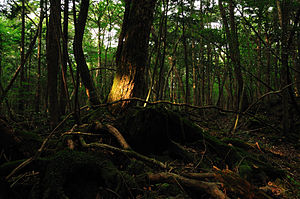Aokigahara

Aokigahara (青木ヶ原), also known as the Sea of Trees (樹海, Jukai), is a 35 km2 forest that lies at the north west base of Mount Fuji in Japan. The forest contains a number of rocky, icy caverns, a few of which are popular tourist destinations.
The forest, which has a historic association with demons in Japanese mythology, is a popular place for suicides; in 2002, 78 bodies were found, despite numerous signs, in Japanese and English, urging people to reconsider their actions.[1]
Due to the wind-blocking density of the trees, and an absence of wildlife, the forest is known for being eerily quiet.[1]
Geography
The forest floor consists primarily of volcanic rock and is difficult to penetrate with hand tools such as picks or shovels. There are also a variety of unofficial trails that are used semi-regularly for the annual "body hunt" done by local volunteers, who mark their search areas with plastic tape.[2] The plastic tape is never removed, so a great deal of it litters the first kilometer of the forest, past the designated trails leading to tourist attractions such as the Ice Cave and Wind Cave. After the first kilometer into Aokigahara towards Mount Fuji, the forest is in a much more "pristine" condition, with little to no litter and few obvious signs of human contact.
Visitors and suicides
The forest is a popular place for suicides, reportedly the world's second most popular suicide location after San Francisco's Golden Gate Bridge.[3][4] This popularity is often attributed to the 1960 novel Nami no Tō (波の塔) by Seichō Matsumoto,[5][6] which ends with two lovers committing suicide in the forest. However, the history of suicide in Aokigahara dates from before the novel's publication, and the place has long been associated with death: ubasute may have been practiced there into the 19th century, and the forest is reputedly haunted by the ghosts of those left to die.[7]
Since the 1950s, more than 500 people have lost their lives in the forest, mostly suicides,[4] with an average of approximately 30 counted yearly.[8] In 2002, 78 bodies were found within the forest, replacing the previous record of 73 in 1998.[9] In 2003 the rate climbed to 100, and in recent years the local government has stopped publicizing the numbers in an attempt to downplay Aokigahara's association with suicide.[7] In 2004, 108 people killed themselves in the forest. In 2010, 247 people attempted suicide in the forest, 54 of whom were successful.[10]
The high rate of suicide has led officials to place signs in the forest, in Japanese and English, urging those who have gone there in order to commit suicide to seek help and not kill themselves. The annual body search, consisting of a small army of police, volunteers and attendant journalists, began in 1970.[11]
See also
References
- ^ a b Zack Davisson. "The Suicide Woods of Mt. Fuji". Seek Japan.
- ^ "Intruders tangle 'suicide forest' with tape". Asahi Shimbun. 2008-05-03. Archived from the original on 2008-05-06. Retrieved 2008-05-03.
- ^ Meaney, Thomas. "Exiting Early: Is life worth living? The question is perennial. The answers include 'no'", The Wall Street Journal, April 15, 2006. Accessed November 14, 2009. "In a roundabout way of coming to terms with his death, Mr. Hunt made several trips to the cliffs of Beachy Head on the southern coast of England, which ranks as the third most popular suicide site in the world, after the Golden Gate Bridge and the Aokigahara Woods in Japan."
- ^ a b Amazeen, Sandy. "Book Review: Cliffs of Despair A Journey to Suicide's Edge", Monsters & Critics.December 21, 2005.
- ^ For the title and author: "Amazon.com: 波の塔〈下〉 (文春文庫): 松本 清張: 本" (in Japanese). Amazon.co.jp. Retrieved 11 January 2011.
{{cite web}}: CS1 maint: unrecognized language (link) - ^ "波の塔". Japanese Wikipedia (in Japanese). San Francisco: Wikimedia Foundation. Retrieved 11 January 2011.
{{cite web}}: Unknown parameter|trans_title=ignored (|trans-title=suggested) (help)CS1 maint: unrecognized language (link) - ^ a b Studio 360:Suicide Forest. Studio 360 in Japan (radio program). January 8, 2010. Accessed: February 11, 2010.
- ^ Hadfield, Peter. "Japan struggles with soaring death toll in Suicide Forest", The Sunday Telegraph (London). June 16, 2001.
- ^ "'Suicide forest' yields 78 corpses". The Japan Times. 2003-02-07. Retrieved 2008-05-03.
- ^ Gilhooly, Rob, "Inside Japan's 'Suicide Forest'", Japan Times, 26 June 2011, p. 7.
- ^ "Japan's harvest of death". The Independent. London. 2000-10-24. Retrieved 2008-05-03.
External links
- CNN article about the forest
- VBS.TV video segment about the suicide patrol (via BoingBoing)
- Studio 360 in Japan: Suicide Forest - Radio program Studio 360 features a segment on Aokigahara as an extra for the 2010 'In Japan' episode.
- Article detailing Japan's 'Forest of Death'
